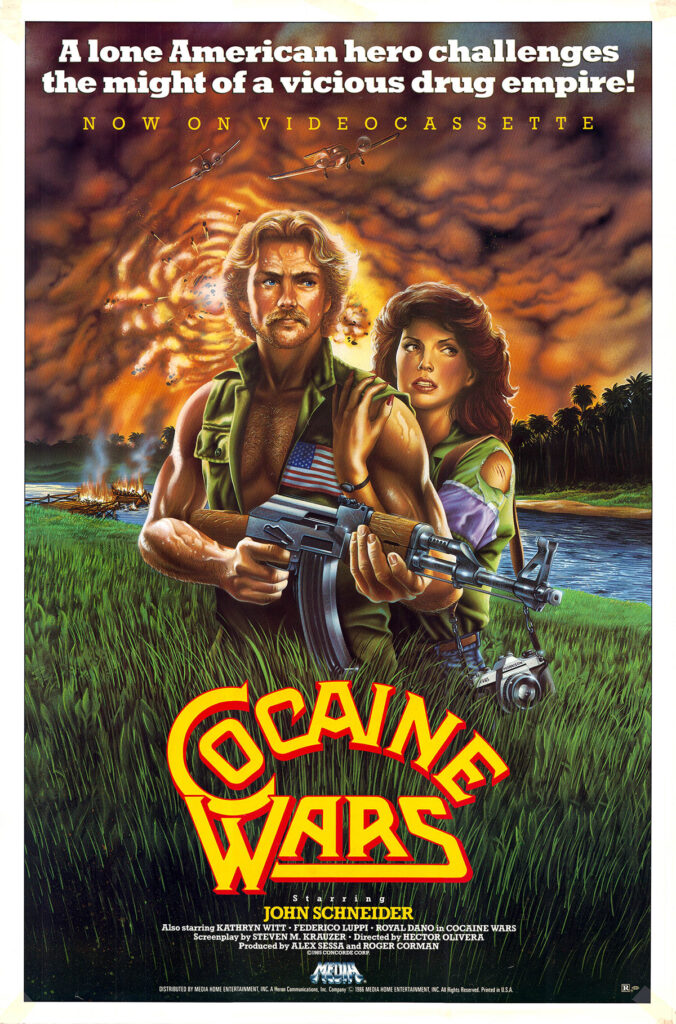There are a lot of plot and characters to keep track of in Cocaine Wars, Héctor Olivera’s magnum opus from 1985, from a screenplay by Steven M. Krauzer. It takes place in the cutthroat world of the drug cartels in an unnamed South American country (filming was done in Argentina). There’s cartel boss Gonzalo Reyes (Federico Luppi). His rival, corrupt General Lujan (Rodolfo Ranni). A crusading politician, Marcelo Villalba (Juan Vitali). An expat American coca farmer, Bailey (Royal Dano). A World War II Nazi fugitive turned cartel wannabe, Klausmann (Ivan Grey). A reporter from the States, Janet Meade (Kathryn Witt). And, tying it all together is drug smuggling treetop flyer Cliff Adams (John ‘Bo Duke’ Schneider), who pisses off just about everyone in the movie at some point.
Cliff’s first beef is with Reyes, who, on dubious accusations, kills Cliff’s partner for stealing from the cartel in the opening scene. Cliff is not happy with this, or the fact that Reyes still owes him money from the last smuggling flight. Reyes offers to make good on all debts should Cliff kill Villalba, whose popular support threatens Reyes’s drug empire.  Cliff is having none of it, setting off all the many events of the movie. Lujan tries having cliff killed. Klausmann tries having Cliff killed. Bailey…doesn’t try to kill Cliff, but I have to mention it’s pretty funny watching Royal Dano spoon cocaine. His main claim to fame was being Disney’s go to choice whenever they needed an Abraham Lincoln. Four score and seven bumps ago, indeed.
Cliff is having none of it, setting off all the many events of the movie. Lujan tries having cliff killed. Klausmann tries having Cliff killed. Bailey…doesn’t try to kill Cliff, but I have to mention it’s pretty funny watching Royal Dano spoon cocaine. His main claim to fame was being Disney’s go to choice whenever they needed an Abraham Lincoln. Four score and seven bumps ago, indeed.
Anyway, Janet Meade is, of course, Cliff’s old flame, giving this flick a failing grade on the Bechdel test in the second or third scene they share together. She’s supposed to be in South America chasing the story of a lifetime, but, hey, John Schneider was too devilish to ignore in 1985.
Many convolutions later, viewers will have been treated to car chases and action set pieces, all of which move back and forth between impressive and scatterbrained. An example is a car chase along a very dangerous mountain road. Filming must have been precarious. But the editing is jumpy, almost more appropriate for an old silent film rather than something from 1985.
It’s in the final sequence where viewers will be able to tell Olivera and producer Roger Corman had been saving their pennies. Cliff goes full Rambo, leading to explosions to rival those found at the end of John Carpenter’s The Thing. It’s an impressive ending to a film that Olivera and company seemed to be making up as they went along. There’s no detail to all the machinations the characters go through, and that’s a good thing. This is a Roger Corman-produced movie, after all. Spending too much time on the intrigue instead of the action would not have resulted in the next Year of Living Dangerously. It would have just sucked.
All the gunplay, fights, chases, explosions, and Schneider’s cowboy swagger give Cocaine Wars a good watchability score compared to its objective quality. As for that quality, Olivera directed five movies for Corman, and they’re the lowest rated on IMDb in his career. That points to this film’s flaws not necessarily being Olivera’s fault. Indeed, this is one of many films he made that profiles the struggles of Argentinians and other South American peoples, but the Corman touch meant this was the most shallow. He sold a piece of his soul to get to Hollywood, and his loss is our gain. Cocaine Wars enters the Watchability Index at #153, displacing Child’s Play 3.
